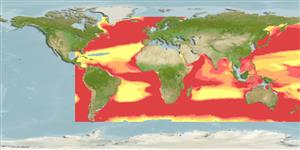Preferred temperature (Ref.
123201): 3 - 19.7, mean 7.6 °C (based on 4609 cells).
Phylogenetic diversity index (Ref.
82804): PD
50 = 0.7500 [Uniqueness, from 0.5 = low to 2.0 = high].
Bayesian length-weight: a=0.00347 (0.00164 - 0.00733), b=3.19 (3.00 - 3.38), in cm total length, based on LWR estimates for this (Sub)family-body shape (Ref.
93245).
Nivel trófico (Ref.
69278): 3.2 ±0.35 se; based on food items.
Resiliencia (Ref.
120179): Medio, población duplicada en un tiempo mínimo de 1.4-4.4 años (Assuming tmax>3).
Fishing Vulnerability (Ref.
59153): Low vulnerability (21 of 100).
Nutrients (Ref.
124155): Calcium = 18.9 [5.2, 84.2] mg/100g; Iron = 0.422 [0.123, 1.324] mg/100g; Protein = 14 [11, 17] %; Omega3 = 0.165 [0.052, 0.541] g/100g; Selenium = 12.8 [3.5, 51.4] μg/100g; VitaminA = 37.4 [5.1, 305.3] μg/100g; Zinc = 0.561 [0.250, 1.389] mg/100g (wet weight);
